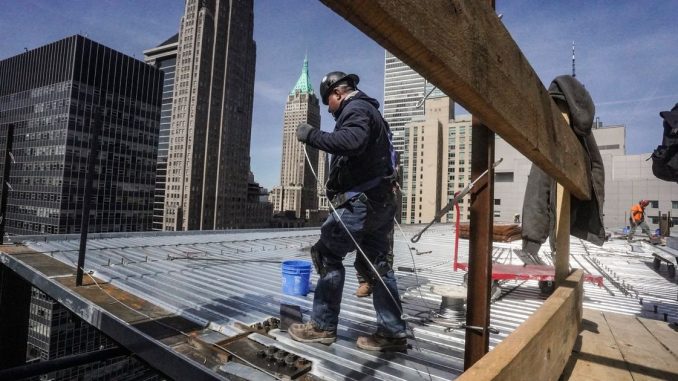
WASHINGTON (AP) — America’s employers added a robust 253,000 jobs in April, evidence of a labor market that still shows surprising strength despite rising interest rates, chronically high inflation and a banking crisis that could weaken the economy.
The unemployment rate ticked down to 3.4%, matching a 54-year low. Last month’s hiring gain compared with 165,000 in March and 248,000 in February, and is at a level considered vigorous by historical standards.
The job market has remained strong despite the Federal Reserve’s aggressive campaign of interest rate hikes over the past year to fight inflation. Layoffs are still relatively low, job openings comparatively high. Still, the ever-higher borrowing costs the Fed has engineered have weakened some key sectors of the economy, notably the housing market.
Since hitting a four-decade high last year, inflation has steadily eased yet is still well above the Fed’s 2% target level.
Fed Chair Jerome Powell himself sounded somewhat mystified this week by the job market’s durability. The central bank has expressed concern that a robust job market exerts upward pressure on wages — and prices. It hopes to achieve a so-called soft landing – cooling the economy and the labor market just enough to tame inflation yet not so much as to trigger a recession.
Xinhua News Agency via Getty Images
One way to do that, Powell has said, is for employers to post fewer job openings. And indeed the government reported this week that job openings fell in March to 9.6 million — a still-high figure but down from a peak of 12 million in March 2022 and the fewest in nearly two years.
The Fed chair said he was optimistic that the nation could avoid a recession. Yet many economists are skeptical and have said they expect a downturn to begin sometime this year.
Another encouraging sign for the Fed is that more Americans are looking for work. The more workers who are available to employers, the less pressure employers face to raise pay.
Still, steadily rising borrowing costs have inflicted some damage. Pounded by higher mortgage rates, sales of existing homes were down a sharp 22% in March from a year earlier. Investment in housing has cratered over the past year.
America’s factories are slumping, too. An index produced by the Institute for Supply Management, an organization of purchasing managers, has signaled a contraction in manufacturing for six straight months.
Even consumers, who drive about 70% of economic activity and who have been spending healthily since the pandemic recession ended three years ago, are showing signs of exhaustion: Retail sales fell in February and March after having begun the year with a bang.
The Fed’s rate hikes are hardly the economy’s only serious threat. Congressional Republicans are threatening to let the federal government default on its debt, by refusing to raise the limit on what it can borrow, if Democrats don’t accept sharp cuts in federal spending. A first-ever default on the federal debt would shatter the market for U.S. Treasurys — the world’s biggest — and possibly cause an international financial crisis.
The global backdrop already looks gloomier. The International Monetary Fund last month downgraded its forecast for worldwide growth, citing rising interest rates around the world, financial uncertainty and chronic inflation.
Since March, America’s financial system has been rattled by three of the four biggest bank failures in U.S. history. Worried that jittery depositors will withdraw their money, banks are likely to reduce lending to conserve cash. Multiplied across the banking industry, that trend could cause a credit crunch that would hobble the economy.
At the staffing firm Robert half, executive director Ryan Sutton still sees “pent-up demand’’ for workers.
Applicants, not employers, still enjoy the advantage, he said: To attract and keep workers, he said, businesses — especially small ones — must offer flexible hours and the chance to work from home when possible.
“Giving a little bit of schedule flexibility so that somebody might finish their work late or early so that they can take care of children and family and elderly parents — these are the things that the modern employee needs,’’ Sutton said. “To not offer those and to try to still have a 2019 business model of five days a week in an office — that’s going to put you at a disadvantage” in finding and retaining talent.


Be the first to comment